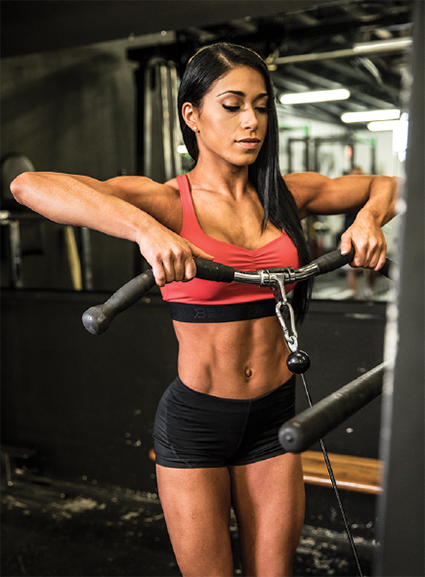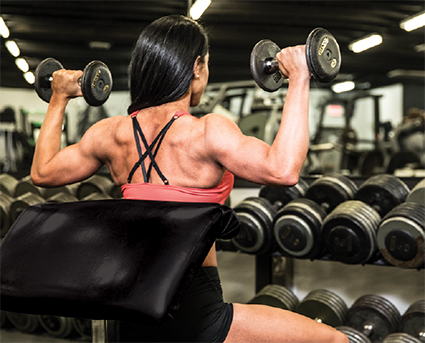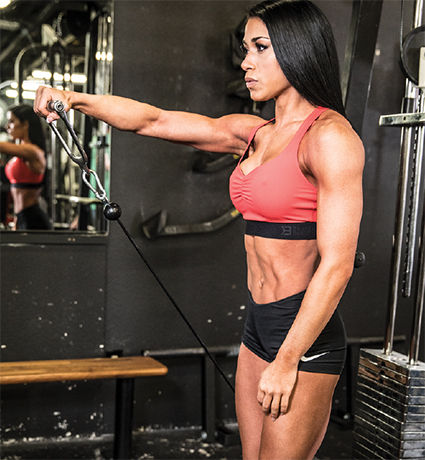Quick Fix for Lagging Delts

Use physics to shake up your shoulder training in a way free weights simply can’t.
No one’s gonna argue with making free weights your first choice of equipment when looking to build muscle. But as your muscle groups adapt to a training stimulus over time, the marginal gains become less impressive. That’s the law of diminishing returns—and yes, it’s an actual law related to lifting—in action.
One of the best ways to creating a novel stimulus is to change the angle at which the muscle is working, which is why you do decline and incline presses on chest day and not just flat-bench presses. One of the easiest ways to change the training angles with shoulders is to simply do the same free-weight movements on cables because the direction of gravity is altered.
How can you violate Sir Isaac Newton’s most famous law? Well, you don’t; the pulley system on a cable apparatus does. Check for yourself: Drop a five-pound plate and it heads directly for the floor (or your foot); alternatively, drop a cable handle with five pounds on the stack and it instead heads directly toward the position at which the pulley is located. In fact, the direction of “gravity” in the latter case is at whichever position the pulley is located—high or low.
If you apply this thinking to shoulder day, a number of tried-and-true free-weight movements that target individual delt heads can be turned into novel training stimuli simply by doing them with cables.
 There’s an added benefit: You can do them all on the same piece of equipment (after a shoulder press to start your workout, of course). No hunting for equipment, weights, or machines that are already taken by other gym members and lengthening your workout. What’s more, with most cable exercises you can do the movement bilaterally (with both sides simultaneously) or unilaterally, which each option offering unique advantages.
There’s an added benefit: You can do them all on the same piece of equipment (after a shoulder press to start your workout, of course). No hunting for equipment, weights, or machines that are already taken by other gym members and lengthening your workout. What’s more, with most cable exercises you can do the movement bilaterally (with both sides simultaneously) or unilaterally, which each option offering unique advantages.
You can also easily do advanced training techniques, with cables, supersets and drop sets being the most obvious. But you want to remember that because nearly all cable shoulder exercises are isolation moves by nature—that is, they target just a single delt head—you don’t want to train them particularly heavy. Don’t go any heavier than using your 8RM, which is a weight you can do for just eight reps with good form. Heavy loads put quite a bit of pressure on the joint when doing single-joint movements and are never intended to be done with near-maximal loads. You can do that with multi-joint exercises.
Not all shoulder cable exercises are single-joint in nature: the upright row is the exception here. It works the middle and front delt heads to varying degrees, which is discussed below, but also includes the upper traps as well.
The workout here begins with a relatively heavy load for sets of overhead presses, a movement that’s virtually impossible to do with cables. Overhead presses are your best choice to start any shoulder workout because they engage more muscle groups, allow you to train heavier, and do a better job of spiking anabolic-hormone release. While we’ve chosen the seated dumbbell version, you’re not limited to that movement only, especially if you’re in a hurry and the gym is crowded.
 These four items below are not intended to be running copy but rather copy that can be captions to the groups of exercises identified in each.
These four items below are not intended to be running copy but rather copy that can be captions to the groups of exercises identified in each.
Target: Multiple Delt Heads
 The family of overhead presses are the best deltoid builders because they engage the greatest degree of muscle mass by definition: They’re multi-joint movements. Do them first in your workout after your joints are warmed up and use challenging weights at the lower end of the hypertrophy rep range (8 to 12, sometimes extended to 6 to 12).
The family of overhead presses are the best deltoid builders because they engage the greatest degree of muscle mass by definition: They’re multi-joint movements. Do them first in your workout after your joints are warmed up and use challenging weights at the lower end of the hypertrophy rep range (8 to 12, sometimes extended to 6 to 12).
Not all overhead presses are the same; the more your elbows pull forward as you lower the weight, the more the front delts contribute at the expense of the middle delts. Arnold presses and barbell presses in front of the neck fall into this category. Behind-neck presses and dumbbell pressesin which your elbows go directly out to your sides hit the middle delt more strongly. This family of exercises doesn’t hit the rear delts much, but all kinds of rows in fact do (which is why some bodybuilders train rear delts on back day).
Upright rowsare also multi-joint shoulder exercises. As with overhead presses, the more your upper arms travel directly out to your sides, the more the middle delts are involved, and the more they pull forward, the more the front delts kick in. You can increase one at the expense of the other by adjusting your grip width on the bar. That is, a wider grip will allow your elbows to go more directly out to your sides, and hence makes this a better choice for focusing on the middle delts.
Target: Front Delt
 When you raise your extended arm from your side to a point directly in front of you, the front (anterior) delt is best targeted. Maintain a fairly straight arm; the more you bend your elbow, the lighter the weight feels because torque is reduced on the target muscle (a principle from physics).
When you raise your extended arm from your side to a point directly in front of you, the front (anterior) delt is best targeted. Maintain a fairly straight arm; the more you bend your elbow, the lighter the weight feels because torque is reduced on the target muscle (a principle from physics).
Bilateral Version:Thefront cable raise with a ropeor straight bar is best done with the cable running between your legs, which means you’d best get situated close to the pulley or it’ll rub against you on the way up. The difference between the overhand and neutral grip is negligible, so choose the version that feels most comfortable.
Unilateral Version:You’ll want to change your body position relative to the pulley so that your working-side shoulder lines up with it. The D-handle is typically your handle of choice, but using a single rope or even just the rubber ball (sans handle)are other options, but neither significantly alters muscle recruitment.
Target: Middle Delt
 This delt head is best targeted by raising your elbow (and hand) directly out to your side in what’s called the lateralplane. Some folks don’t realize the key is to watch where the upper arm (from shoulder joint to elbow) travels; that is, when the weight’s too heavy, people will often hinge at the elbow, raising their hand instead of the upper arm, but this sacrifices the range at which the upper arm travels, thus reducing middle-delt engagement. Bring that elbow directly out to your side and as high as possible. As for the elbow, keep it locked in the slightly bent position for the duration of the movement. Again for you physicists, a huge bend in your elbow makes the movement easier by again reducing torque; and extending your arm duringthe motion recruits the triceps into the effort. For you editors out there like me, calling this movement a side lateralis a pet peeve because it’s redundant.
This delt head is best targeted by raising your elbow (and hand) directly out to your side in what’s called the lateralplane. Some folks don’t realize the key is to watch where the upper arm (from shoulder joint to elbow) travels; that is, when the weight’s too heavy, people will often hinge at the elbow, raising their hand instead of the upper arm, but this sacrifices the range at which the upper arm travels, thus reducing middle-delt engagement. Bring that elbow directly out to your side and as high as possible. As for the elbow, keep it locked in the slightly bent position for the duration of the movement. Again for you physicists, a huge bend in your elbow makes the movement easier by again reducing torque; and extending your arm duringthe motion recruits the triceps into the effort. For you editors out there like me, calling this movement a side lateralis a pet peeve because it’s redundant.
Unilateral Version: Unlike the common one-arm dumbbell version in movement, the cable lateral raisehas tension on the middle delt in the bottom position because the pull is coming not just from below but also across your body. There’s a slight difference in angle when the cable runs in front of your body as opposed to behindit, which is why I sometimes alternate which version I do from one workout to the next for better overall middle-delt development. You can even trying leaning out from a cable post so long as you still try to confine the movement to the lateral plane.
Bilateral Version:You can try standing in the middle of both cables, but I think this is awkward because you’re so far from the pulleys. I strongly prefer the unilateral option.
Target: Rear Delt
 To work the rear delts with dumbbells, you bend over with your arms almost fully extended and draw the weights out and up to your sides as high as you can, maintaining the slightly bent arm position. For some, it’s an easier motion to learn on the pec-deck machine as a reverse flye, a machine movement that locks you into the correct arm position with the motion nearly identical. Each version makes it very difficult to cheat and recruit the triceps unless you turn it into a row. Moving over to cables, you’re using a near-exact motion.
To work the rear delts with dumbbells, you bend over with your arms almost fully extended and draw the weights out and up to your sides as high as you can, maintaining the slightly bent arm position. For some, it’s an easier motion to learn on the pec-deck machine as a reverse flye, a machine movement that locks you into the correct arm position with the motion nearly identical. Each version makes it very difficult to cheat and recruit the triceps unless you turn it into a row. Moving over to cables, you’re using a near-exact motion.
Bilateral Version: Called the cable reverse flye, here the pulleys are positioned up high as you grasp the rubber ball and stand midway between the cables. A lot can—and does—go wrong in the execution of this particular movement, namely the opening and closing of the elbows, which turns this into a far less effective multi-joint movement that engages the triceps. That’s a common error you’ll see in any gym! As you pull across and back in a wide arc with your arms locked in the slightly bent position, billow your chest outward to extend the range of motion.
Unilateral Version: The one-arm bent-over cable lateral raiseis done much like how you’d complete the version with a single dumbbell. I prefer holding onto the rubber ball (as opposed to a D-handle) to ensure the wrist doesn’t become a limiting factor as fatigue sets in (you always want a neutral wrist when holding a handle). Use a wide, sweeping arc-like motion.
Get articles like this one delivered to your email each month by signing up for Muscle Insider’s mailing list. Just click here.

